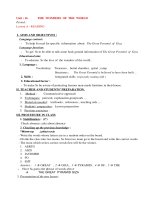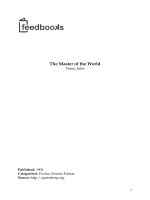ASSESSING IMPACTS OF THE WORLD ENERGY PRICE CRISIS ON VIETNAM RICE PRICE
Bạn đang xem bản rút gọn của tài liệu. Xem và tải ngay bản đầy đủ của tài liệu tại đây (1.06 MB, 51 trang )
VIETNAM NATIONAL UNIVERSITY, HA NOI
UNIVERSITY OF ECONOMICS AND BUSINESS
FACULTY OF INTERNATIONAL ECONOMICS AND BUSINESS
THESIS
ASSESSING IMPACTS OF THE WORLD ENERGY PRICE
CRISIS ON VIETNAM RICE PRICE
Instructor: M.Econ. Tran Viet Dung
Student: Nguyen Thi Nhung Anh
Class: QH-2010E-CLC
Faculty of International Economics and Business
Hà Nội, 10/2014
ABBREVIATIONS...............................................................................................I
LIST OF TABLES..............................................................................................II
LIST OF FIGURES...........................................................................................III
ACKNOWLEDGEMENT................................................................................IV
CHAPTER 1. INTRODUCTION.......................................................................1
1.1.
Research objectives ........................................................................... 3
1.2.
Research questions ............................................................................ 3
1.3.
Research scope ................................................................................... 3
1.4.
Methodology......................................................................................4
CHAPTER 2. LITERATURE REVIEW..........................................................5
CHAPTER 3. DATA AND METHODOLOGY..............................................15
3.1.
Data ................................................................................................... 15
3.2.
Methodology : Engle-Granger cointegration test ........................ 20
CHAPTER 4. RESULTS AND DISCUSSIONS..............................................23
CHAPTER 5. CONCLUSION..........................................................................30
CHAPTER 6. LIMITATION............................................................................33
REFERENCES...................................................................................................34
APPENDIX 1......................................................................................................36
APPENDIX 2...................................................................................................38
APPENDIX 3................................................................................................40
i
ABBREVIATIONS
APEC
Asia-Pacific Economic Cooperation
ECM
Error correction model
FAO
Food and Agriculture Organization.
GDP
Gross Domestic Product
IFS
International Financial Statistics
IMF
International Monetary Fund
UK
United Kingdom
US
United States
USD
United States dollar
USDA
United States Department of Agriculture.
WTI
West Texas Intermediate
ii
LIST OF TABLES
Table 4.1
Dickey-Fuller test on rice price in level
Table 4.2
Dickey-Fuller test on oil price in level
Table 4.3
Respective statistics
Table 4.4
Dickey-Fuller test on rice price in 1st difference
Table 4.5
Dickey-Fuller test on oil price in 1st difference
Table 4.6
Respective statistics
Table 4.7
Least squares estimate
Table 4.8
Dickey - Fuller test on εt
iii
LIST OF FIGURES
Figure 3.1
World crude oil spot price in the period of 1989-2014
Figure 3.2
Vietnam rice export price from 2003 to 2014 ( 4 types )
Figure 3.3
Vietnam average rice price from 1989 to 2014
Figure 3.4
Some countries’ rice export price from November, 2011 to
December , 2012
iv
ACKNOWLEDGEMENT
During the time of accomplishing this thesis, I have received enthusiastic
support and encouragement of many people. First of all, I would like to express
my sincere thanks to my instructor, M.Econ. Tran Viet Dung, who has
instructed, supported and helped me dedicatedly to achieve a clearer structure
and a better content so that I can complete this argument.
Besides, I wish to extend my gratitude to my friends, especially the class
QH-2010E-CLC having contributed many useful ideas for me. I also would like
to deeply thank to my parents because they always encourage me and give me
motivation in process of doing this thesis.
Due to the limited knowledge, my thesis might have mistakes and shortcomings.
Therefore, I am looking forward to getting enthusiastic comments and
contributions of all teachers and students.
Hanoi , November 2014
Nguyen Thi Nhung Anh
1
CHAPTER 1. INTRODUCTION
Scarcity of energy makes developed countries navigate towards biofuels
whose inputs are agricultural products, which have caused serious food
shortages. In addition, there are other factors such as rapid population growth
pushing up food prices, climate change, and poor countries are the place suffered
the most severe consequences.
Food has never been a touchy issue like today. According to Food and
Agriculture Organization (FAO), food prices are likely to cause a new food
crisis. Only in May 7, 2012, global food prices have increased by 6%. Harsh
weather has negatively affected crop cereals, soybeans and wheat in many areas
of the United States, Russia, Ukraine, Kazakhstan ... In the Balkans,
unprecedented drought resulted in damage estimated at over one billion euros for
the agricultural sector in this one of the poorest regions in Europe.
Although food prices are still well below the peaks of the February, 2011 and the
situation is not serious enough to cause a global crisis in the short term, the trend
of escalating food prices are concerning. In high-income countries such as the
USA and Western Europe, rising food prices suddenly creates many challenges,
forcing families to make difficult choices in spending. In low-income countries,
rising food prices caused enormous difficulties, forcing people to make survival
decisions.
Roots of currently unstable food situation have originated since thirty
years ago, when investment in agriculture began to decline. In 1979, financial
support for agriculture accounted for 18% of total support. But by 2008, this
figure was only 4.3%. In developing countries, government investment in this
2
sector also declined over this period, with the level of reduction is one third in
African countries and about two thirds in Asia and Latin America. In many
developing countries, especially low-income countries, downturn investment is
even associated with loopholes in government policy.
When food prices soared in the period from September, 2006 to June,
2008, it is obviously proclaimed that the world is coping up with a new
instability. Moreover, the fact that world's population is forecasted to reach 9.1
billion in 2050, severe impacts from climate change are negative factors leading
to a large scale food crisis .
According to the warns of FAO leader, JG Da Sin-va, food prices will
escalate and volatile in the next 10 years. Mr. Da Sin-va offers countries to stop
taking food crops (such as corn) for fuel production and reckons that this
problem can be avoided in the future, as more advanced biofuel technology will
be applicated along with the increasing use of non-food crops.
However, only the coordination between non-governmental organizations, state
enterprises brings about the effects for ensuring global food security. At the
APEC Summit in Russia in August, 2012, the governments issued a series of
measures to ensure food security for their citizens. According to that, there are
three missions needed to be solved as quickly as possible. First, the world should
remove the use of unsustainable biofuels. Second, it is in need to increase
investment in the Africa and Latin America regions. Third, the government of
developing countries need to establish long-term partnerships with the private
sector, international donors to stimulate investment in commercial agriculture.
With these measures, the governments hope that food shortages will soon be
resolved thoroughly. Global food security can be hold.
3
Facing to the global energy and food crisis, a country depending on
agriculture and oil imports like Vietnam is also more or less affected. This paper
aims to answer the following questions: (1) Is there a long-term relationship
between the world energy price and the rice price in Vietnam ? (2) How does
Vietnam rice market react to shocks in energy prices ? (3) Do the temporary
shocks in Vietnam rice market cause long-term impacts on the price of rice?
In the condition of not understanding the dynamic adjustment process on
Vietnam's rice market prior to energy prices and other external shocks,
answering to these questions becomes necessary, helping evaluating and building
such effective and reasonable policies related to rice.
1.1.
Research objectives
The study aims to analyze whether the world energy crisis put Vietnam
rice price under any pressure in short or long term. It also gives some proposals
and solutions for Vietnam's rice exports prior to fluctuations in world energy
prices.
1.2.
Research questions
The following questions will be answered :
(1)
Is there a long-term relationship between the world energy price and the
rice price in Vietnam ?
(2)
How does Vietnam rice market react to shocks in energy prices ?
1.3.
Research scope
The paper examines the world energy crisis in the stage from 1989 to
2014, considers the situation of Vietnam rice price during this period, then uses
4
the Engle-Granger cointegration test to draw conclusions of whether the world
energy crisis has any impacts on Vietnam's rice market or not .
1.4. Methodology
The study uses the quantitative research method, with the content of
Engle-Granger cointegration test . This model consists of three smaller models as
following :
DF Test to check whether data series are stationary or not
Ordinary least squares estimation process with a strong bias, overcoming
error changes to estimate the coefficient correlation 1 and forecast error
εt
DF test on εt to conclude whether 2 variables have cointegration
relationship or not
5
CHAPTER 2. LITERATURE REVIEW
There are a mountain of papers discussing the issue of how the world oil
crisis affects food prices.
The similar points of these papers are that they
indicated two main effects of the oil price crisis on food prices. First, an increase
in oil prices pushes up the cost of food production and transportation. Second,
escalating oil prices led to a shift towards biofuels, making the countries
gradually reduce the cultivated areas to plant oilseeds. Then, the authors offer
suggestions and solutions for the governments to effectively convert the
cultivated area as well as policies for sustainable agricultural development. The
studies below is the typical ones :
Ronald Trostle ( 2008 ) analyzes factors contributing to higher food
prices and forecasts further developments of world food production. World
market prices for major food commodities such as grains and vegetable oils
have risen sharply to historic highs of more than 60 percent above levels just 2
years ago. Many factors have contributed to the run up in food commodity
prices. Recent factors that have further tightened world markets include
increased global demand for biofuels feedstocks and adverse weather conditions
in 2006 and 2007 in some major grain and oilseed producing areas. Other factors
that have added to global food commodity price inflation include the declining
value of the U.S. dollar, rising energy prices, increasing agricultural costs of
production, growing foreign exchange holdings by major food importing
countries, and policies adopted recently by some exporting and importing
countries to mitigate their own food price inflation. On the supply side, largely
due to rising energy prices, production costs for most of the world’s farmers
6
were increasing.
If petroleum prices continue to rise, costs of agricultural
production will rise, as will the cost of processing, and the cost of transporting
products to markets both within a country and exporting to other countries.
However, the author point out that most feedstocks used to produce biofuels
come from annual crop production. Perennial crops, such as oil palm and
coconut, as well as previously used vegetable oils and fats, that are feedstocks
for biodiesel are the primary exceptions. Use of crops for biofuel may divert
some cropland away from producing crops used for food, feed, and non-biofuel
industrial uses. However, in some cases, coproducts such as distiller’s grains (a
byproduct when producing ethanol from corn) or soybean meal (a joint product
in producing soybean oil from soybeans), continue to be available for food or
feed use when biofuels are produced. Also, because global total area harvested is
rising, increases in land used to produce biofuel feedstocks have not led to
equivalent declines in area planted to traditional food and nonfood uses.
Therefore, increasing demand for biofuels just contributes to higher food prices
but does not have impact in food supply. In conclusion, the study shows that
energy prices just have impacts on food price in production and supply side.
Jannie de Villiers ( 2008 ) also wrote an article about that issue. The
increase in fossil fuel prices has urged the world to reconsider alternative sources
to produce energy. The biofuel industry erupts on the back of increased oil
prices. The consequence of this development increases the demand for grains
and oil seeds substantially over a short period of time followed by all time high
prices.The pressure to supply more inputs has consequently increased the prices
of those products substantially with the consequential increase in the cost
producing food. This in itself will again worsen the food security issue regarding
7
affordability. The article charts out one solution to the current situation which is
the responsible application of biotechnology. The availability of biotechnology
for maize and soya beans used for animal feed and industrial usage could speed
up production to catch up with the growing demand. In a macroscopic way,
quick reaction should be launched by governments to create a policy
environment to attract new investments in agriculture to ensure food security.
Reliable structures, free from corruption, should also be developed to directly
address the needs of the poor during the lag time that agriculture needs to react
to this new challenge.
Aditya Chakrabortty ( 2008 ) states that biofuel is the main reason for
rising food commodity prices. It maps out that biofuels have forced global food
prices up by 75% - far more than previously estimated - according to a
confidential World Bank report obtained by the Guardian. The figure
emphatically contradicts the US government's claims that plant-derived fuels
contribute less than 3% to food-price rises. It will add to pressure on
governments in Washington and across Europe, which have turned to plantderived fuels to reduce emissions of greenhouse gases and reduce their
dependence on imported oil. Rising food prices have pushed 100m people
worldwide below the poverty line, estimates the World Bank, and have sparked
riots from Bangladesh to Egypt. Government ministers here have described
higher food and fuel prices as "the first real economic crisis of globalisation". It
is obviously illustrated that production of biofuels has distorted food markets in
three main ways. First, it has diverted grain away from food for fuel, with over a
third of US corn now used to produce ethanol and about half of vegetable oils in
the EU going towards the production of biodiesel. Second, farmers have been
8
encouraged to set land aside for biofuel production. Third, it has sparked
financial speculation in grains, driving prices up higher.
Anuradha Mittal ( Executive Director of the Oakland Institute ) ( 2009)
examines the 2008 global food price crisis, identifying long- and short-term
causes as well as the two factors which distinguish the 2008 food price increases
from earlier episodes –speculation and diversion of food crops to biofuels. The
paper contends that while most attention has been focused on factors including
higher energy costs, decline in growth of agricultural production and increased
demand from emerging economies, it is essential to examine the structural
causes of growing food insecurity to understand what is really behind the food
price crisis. The paper points out that, according to the USDA’s cost-ofproduction surveys and forecasts, doubling of prices of energy intensive
components of production, including fertilizer and fuel, increased production
costs for the United States corn, soybeans, and wheat by around 21.7 per cent
between 2002 and 2007 (Mitchell, 2008). This rise in the cost of production
increased the export prices of the major United States food commodities by
about 15–20 per cent between 2002 and 2007 (Mitchell, 2008). In a general way,
the prices of energy have direct impacts on the prices of food, because an
increase in energy prices will lead to an increase in food cost production.
However, the pressure that an increase in energy prices put on food price crisis is
just occurring on the surface. The impacts of several factors including systemic
decline in investment in agricultural productivity; state’s reduced regulatory role
in agricultural production and trade; indiscriminate opening of agricultural
markets which has resulted in import surges, and emphasis on cash crops, on
food security of developing nations are real reasons behind the food price crisis.
9
Ibrahima Hathie, Center for Democratic Development, Ghana ( 2012 )
analyzes the impacts of world food crisis on Sub-Saharan Africa due to the
indispensible role of agriculture with this region. The agricultural sector, which
accounts for 30% of GDP, is an important source of export earnings and remains
the major sector absorbing the growing labor force. 60% of the economically
active population works in the agricultural sector. Meanwhile energy and food
security issues have taken center stage in light of the recent food price spike.
Sub-Saharan Africa was hard hit by the global food crisis. Underlying causes of
this food crisis include short-term and long-term factors. Rising demand in the
large developing countries, especially for meat and dairy products, has resulted
in an increased use of grains. On the supply side, investments in agriculture have
been declining for more than two decades in developing countries while
developed countries provided subsidies and trade protection to their farmers,
thus further depressing world prices and discouraging investments and
production in developing countries (Elliot, 2006). Recently, sharply rising
energy prices raised production costs and also contributed to increasing the
demand for alternative fuels. Under these circumstances, land diversion from
cereal to biofuels production could have serious consequences for local
communities. In many cases, farmers are encouraged to use intercropping but
they do not apply the efficient spacing between lines. As a result, some farmers
have lost up to 60% of their cereal production without securing their jatropha
output. Therefore, there was a lack of food in Sub-Saharan Africa, whereas, the
supply for biofuels was still not enough. This paper maps out how energy prices
affect food security in Sub-Saharan Africa, as well as give some
recommendations for African government to compete with that issue.
10
Caroline Lucas MEP, Andy Jones, Colin Hines ( 2012 ) details the extent
to which 21st century food systems are dependent on intensive energy use, and
examines why they are particularly vulnerable to the impact of high energy
prices on the fertilisers, pesticides, plastics, aviation fuel, ‘warehousing on
wheels’ and ‘just in time delivery’ systems, central to the UK’s supermarket
dominated food system. The industrialisation of farming accelerated
dramatically in industrialised countries after World War Two, and began in
many poorer countries as a result of the Green Revolution of the 1950s and
1960s. Yet this reliance on fossil fuels - in the form of fertilisers (which accounts
for around a third of agricultural energy consumption), pesticides, and
hydrocarbon-fuelled farm machinery and irrigation systems – means that
industrialised farming consumes 50 times the energy input of traditional
agriculture; in the most extreme cases, energy consumption by agriculture has
increased 100 fold or more. It has been estimated, for example, that 95% of all of
British food products require the use of oil. The effect of rising oil prices on food
production is only half the story, however. Its effect on the demand for food
commodities is also extremely significant. Since virtually all the crops the UK
currently grow for food can also be converted into automobile fuel, either in
ethanol distilleries or bio-diesel refineries, high oil prices will open a vast new
market for farm products. Those buying commodities for fuel producers will be
competing directly with food processors for supplies of wheat, corn, soybean,
sugarcane, and other key crops. The report ends by outlining the comprehensive
changes necessary to ensure that the food needs of each and every nation are
fully met.
11
Sean Thompson gave a presentation
to a seminar of economists
organised by The International Institute for Research and Education in
Amsterdam in November, 2013. The author proclaims that, in 2008, world food
prices doubled over the previous year. In Fred Magdoff’s words, ‘in 2008,
people woke up to a tsunami of hunger sweeping the world. Food riots occurred
in many countries in the global South and the discontent stemming from the
ongoing volatility of food prices has played a critical part in the events in the
Mena region this year, the so-called Arab Spring‘. A more recent cause of the
food crisis is the diversion of increasing amounts of soya, maize and palm oil
into the production of biofuels (ethanol and bio diesel). For example, in 2008,
around 30% of the entire US maize crop was used to produce ethanol. Estimates
of the degree to which ethanol production has contributed to the rise in world
food price varies from the US Department of Agriculture’s less than 5% to the
World Bank’s approaching 80%. In addition, the effects of global warming on
world agricultural production are starting to make themselves felt. In 2008, there
were major crop failures in Bangladesh, China and Australia, where wheat and
rice crops were devastated by drought, forcing world prices up. In 2010, Russia
banned grain exports until the end of the year because a drought had destroyed
20% of its crop. Climatologists agree that such widespread disruptions in food
production will only increase with the growing instability of the climate across
many regions. These crop failures coincided with the dramatic fall of stock
markets, leading to unprecedented speculation in world commodity markets, the
effect of which was intensified by the very low level of global food stocks after
several years in which demand exceeded supply and the speculation and
hoarding at a local level by elements of the various national borgeiosie. The
12
paper describes a view of world oil and food crisis, as well as the factors
contributing to those crises. These factors combined in 2008 to create a perfect
storm – a storm which, although it has abated to some small degree, is still
raging.
William Laurance ( 2014 ) gives a picture of a big catch: The modern
farming agronomists espouse needs energy — lots of energy — relative to that
used for small-scale farming. It needs energy for farm equipment, irrigation,
refrigeration, lighting and crop transport. It also needs energy to produce
nitrogen fertilizers and yet more energy to mine and transport phosphate. All in
all, modern farming has a serious thirst for energy. For this reason, when energy
prices go up, food prices tend to go up. From 1990 to 2013, the annual price of
oil explained three-quarters of the annual variation in the price of food (cereals,
edible oils, meat, dairy and sugar). So, to feed billions of people without
destroying nature, we must intensify farming. But because intensive farming
relies so heavily on energy, energy prices strongly influence food prices. By
midcentury we’ll need even more: Global energy use is projected to rise by up to
61 percent, according to the World Energy Council, mostly because of growing
consumption by the world’s developing economies.. One of the biggest
challenges will be replacing petroleum — a stable, high-energy-density liquid
fuel that powers virtually the entire global transportation sector and has countless
industrial uses on top of that. For this, biofuels are the most plausible alternative
— but there’s a problem here too. Even if efficient new cellulosic technologies
(which use plant biomass rather than just oils or sugars) should emerge, growing
the amount of biofuel crops we’d need would require enormous expanses of
arable land — land we’ll desperately need to feed people. On top of that, the
13
competition between agriculture and biofuels will make land, and hence biofuels,
more expensive. The article claims the relationship between energy and
agriculture, while providing two recommendations to tackle the food crisis,
which are family planning and energy conservation.
These papers show that the world energy crisis has certain impacts on
food security, rising food commodity prices, especially in countries depending
on food imports like the UK, or in areas depending on agriculture like Africa.
However, there is only one paper assessing how the world energy crisis
influences the rice price with one rice-exported country . It is the report " World
energy price shocks can explain Thailand rice price fluctuations : Cointegration
test " by Aekapol Chongvilaivan, Institute of Southeast Asian Studies (ISEAS)
in 33rd Annual Conference - Federation of ASEAN Economic Sciences
Associations ( 2008 ) with the topic of "Cooperation and development of
ASEAN agricultural and rural areas in the era of globalization". The report
indicates the long-term relationship between the world energy prices and Thai
rice price. With a rice exporter as Thailand, the impact of the oil crisis on
agriculture is not small. The article also launched the policy implications to
separate the rice market of Thailand out of the effects of energy price shocks.
As far as I know, in Vietnam , there are no studies that use quantitative
models to examine the relationship between the world energy prices and
Vietnam food prices. Therefore, my study inherits the ideas from the report of
Mr.Aekapol Chongvilaivan to examine whether there are any relationships
between the world energy prices and Vietnam rice prices . I would use the same
model with the model in the report " World energy price shocks can explain
14
Thailand rice price fluctuations : Cointegration
test "
by Mr.Aekapol
Chongvilaivan. Besides, from the experience of Thailand, I will give proposals
for Vietnam agricultural policies, especially how to separate Vietnam rice
market from fluctuations in the world energy prices.
15
CHAPTER 3. DATA AND METHODOLOGY
3.1.
Data
This study used data of Vietnam rice price and the world energy price
each year in the period from 1989 to 2014 from websites of Vietnam Ministry of
Industry and Trade, Viettrade, Vietnam Customs and Vietnam Ministry of
Finance; International Financial Statistics (IFS); International Monetary Fund
(IMF) and some other related ones.
Figure 3.1. World crude oil spot price in the period of 1989-2014
120
100
80
60
WTI crude oil spot
price
40
Europe Brent crude oil
spot price
20
0
1989 1991 1993 1995 1997 1999 2001 2003 2005 2007 2009 2011 2013
( Source : : />brent-crude-oil/ and drawn by the author )
16
The first oil crisis occurred in 1973 when oil prices increased
dramatically from 20 USD / barrel to 45-50 USD / barrel and the second one
happened in 1979 when oil prices doubled from 50 USD / barrel to around 100
USD / barrel. Then oil prices decreased gradually and became relatively stable
since 1985 at 20-30 USD / barrel.
During this period, in late 1990, oil prices skyrocketed from 30 USD /
barrel to 55 USD / barrel, but quickly returned to the normal level of 30 USD /
barrel in early 1991, so this should be considered only as a spike, not having
severe impacts as the previous crises. Starting after the 2004, oil prices increased
continuously and steadily. In September, 2003, oil prices are below 25 USD /
barrel, in August, 2005 they doubled up to over 60 USD / barrel. In September,
2007, oil prices rose to above 80 USD / barrel and above 99 USD / barrel in
December, 2007.
This has created the fear of the probable third energy crisis, longer than
two previous ones. According to the world's energy experts , in 2015, oil prices
could rise to 380 USD / barrel . Oil price of 60 USD / barrel was high enough
levels to impact the global economy in general, as the fact of the previous oil
crises has shown. Therefore, abnormal changes in oil prices this time would have
such great and awful effects on the world economy. It really would be a tsunami
for all mankind as many economic analysts have envisioned. If right now the
world does not find a way out of our dependence on oil by using alternative
energy, the tragedy of humanity is inevitable.
The world’s growing thirst for oil is likely to create disequilibrium
between crude supply and demand, thus triggering price fluctuations at stock
exchanges around the globe. Over the past decade, consumption volumes have
17
risen from under 80 million barrels per day in 2002 to almost 90 million barrels
per day in 2012. Driven by global economic growth, West Texas Intermediate
crude reached annual average price levels near 100 US dollars per barrel for the
first time in 2008, when worldwide oil consumption exceeded production by
over three million barrels daily. Although the difference can be accounted for by
the production of biofuels and oil from unconventional sources, these figures
show why adjustment measurements are required to balance supply and demand
in the international crude oil market.
Economic theory has shown that prices are a key element to adjust
supply and demand, but political frameworks appear to be the crucial factor in
this case. The WTI price trend will likely be affected by the quality of pipeline
infrastructure between the US Gulf and the nation’s oil-trading hub at Cushing,
as well as political trends in other oil producing regions. With U.S. shale gas
production on the rise, and with Russia accounting for approximately 13 percent
of theworld’s oil production volume, oil prices may just continue their
rollercoaster ride through 2014 and well into 2015. InSeptember 2014, one barrel
of WTI crude cost around 93 U.S. dollars, while the price for a barrel of Brent
stood at around 97 U.S. dollars.
18
Figure 3.2. Vietnam rice export price from 2003 to 2014 ( 4 types )
600
500
400
Rice 5
Rice 10
300
Rice 15
Rice 25
200
100
0
2003 2004 2005 2006 2007 2008 2009 2010 2011 2012 2013 2014
(Source : moit.gov.vn and drawn by the author )
Figure 3.3. Vietnam average rice price from 1989 to 2014
Average rice spot price
600
500
400
300
200
100
0
Average rice spot price









